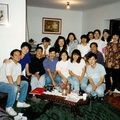There must have been dryers somewhere in South America. Gas or electric, I would have taken either. During my eight years in Brazil, washday usually involved a washboard built into a sink, a hard, square, giant bar of soap and a clothesline. I never stayed anywhere with a dryer, no less a washing machine.
That meant that during the rainy season, washday could last several days as clothes hanging on the line outside were repeatedly rained on in the late afternoon, delaying the drying process; and, having no machine to perform a spin cycle, you got as much water out of your clothes as was proportionate to your hand and arm squeeze strength. For me, that meant that they drooped low on the clothesline as I hung them out dripping water from a cuff or a pant leg.
What this created, interestingly enough, was the potential for what Brazilians called cheiro de mofo. (pronounced, "shay roo jee muh foo.") This phrase might be translated as the "smell of mildew." I simply called it the "dirty dishrag smell." You know that odor, right?
Okay, maybe not. It would be best described as pungent. And you would smell it on people in many places in Brazil -- the metrô, the mall, offices, at camp. Everyone who washed their clothes and hung them out to dry had the same problem: the afternoon rain would fall and the clothes would be another day out on the clothesline.
You understood it. It was a fact of life! When you smelled the cheiro de mofo on someone, you knew the problem. Not a problem of cleanliness, but of climate. That is, until it happens to you!
On my second visit to Brazil, I hitched a ride to São José dos Campos to visit friends there. A young man named Celso (I remember that name! You don’t meet too many people named Celso! Pronounced "sell soo") offered to drive me there. I packed some clothes, threw on a pair of Levis off of the clothesline and away we went.
During the one-hour drive north of São Paulo, I began to smell an odd odor. Now would be the first time the cheiro would happen for me. I thought to myself, "Oh, Celso has that smell." But as we drove and the odor got stronger, I leaned down to pick up a pen I had dropped on the floorboard of the car, bringing my nose close to my jeans. Omigosh! It’s me!!
I would live with that smell for the hour-long drive! Upon arriving at the friend’s home, I immediately asked if I could wash my jeans! It’s not pleasant when it’s you that smells!
The same thing happened to bath towels left to dry on the towel rack in the bathroom. São Paulo, as well as other cities, was characterized by a humid climate. So whether things dried inside or outside – it would result in the same smell! Now what's bad about the bath towel having this cheiro de mofo is when you toweled off, the odor transferred to your skin. Now YOU smell like a dirty dishrag! Great!
I learned that a necessary item to pack (and would be included on the list for all JEMS' future teams) would be a can of Lysol Spray Disinfectant. I picked the pink can: Mountain Air or Country Fresh, I think the name was.
After toweling off, the ritual every time was to spray the towel with Lysol so that the little mildew bacteria (or whatever caused the smell) would be somehow disinfected. So jeans, shirts, underwear, all got sprayed generously with Lysol after being hand wrung of excess water before going on the clothesline. It helped.
And since fragrance is one of the strongest triggers of memory, whenever I spray Lysol from the pink can, I smile. I think of washdays, rainy days, travel days, so many places which became way stations in those eight years in South America.
So for you my American co-workers out there, rest assured. That smell wasn’t you! It was cheiro de mofo!
© 2009 John Katagi






